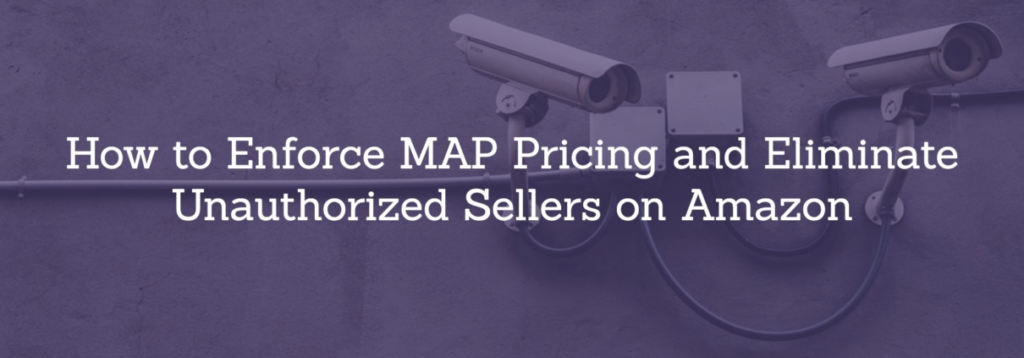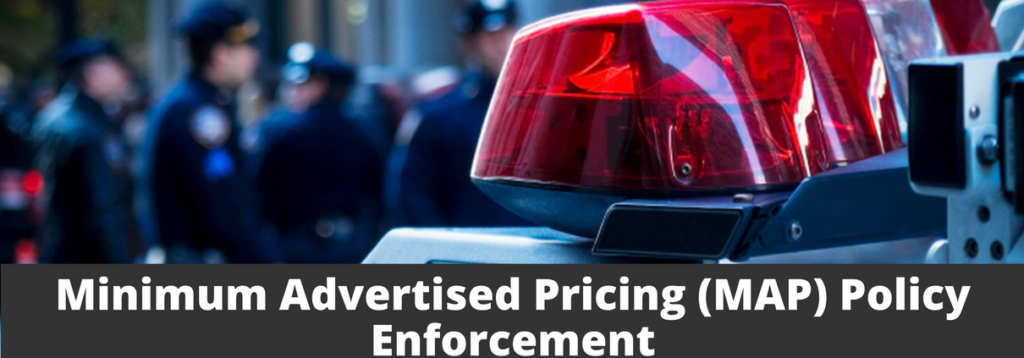How to Increase MAP Compliance on Amazon
Does your company sell to brick & mortar retailers? Are your company’s products also for sale on Amazon – often at prices that are below MAP?
If you’re a brand selling to bricks & mortar retailers and you’re struggling to enforce MAP pricing on Amazon, you are undoubtedly aware of two major issues:
- When your products are available on Amazon below MAP, your brick & mortar retailers tend get pretty upset
- Controlling MAP on Amazon can be a huge challenge
The Challenge of Managing MAP on Amazon
If MAP pricing is important to your brand, managing it on Amazon is an ongoing challenge that you are going to have to deal with.
If you don’t actively manage it, you are essentially giving up control of your product(s) on Amazon – which over the long term, will negatively impact both your relationships with your retail partners, as well as your brand equity overall.
While there is no ‘silver bullet’ for MAP pricing management, there are definitely a number of steps that you can take to keep control of your product listings on Amazon.
Steps to Managing MAP Pricing On Amazon
The first of these steps is to sign an exclusive agreement with a single third party seller and then work with them, and Amazon, to systematically remove all of the other 3rd party sellers on a given product listing.
Once you have decided to work with a single 3rd party seller, ensure that any distributors that sell your products know that in order for any retailer to get an approved wholesale account, these retailers must have a verified physical location, and they aren’t going to be permitted to sell the product on Amazon.com.
The next step is going to be to contact each of the other sellers on your product listing and find out where they got their product from. As a part of this conversation, you should also inform them that they are in violation of your MAP policy, plus they aren’t authorized to sell your products on Amazon. If they don’t agree to remove their listing, you should check how much inventory they have, and then, if necessary, have your attorney send a cease and desist letter.
To check how much inventory they have, simply try to add 999 items to cart and Amazon will tell you how many they have left in the warehouse. If they have a sufficient quantity to justify the effort, then go ahead and have your attorney send the letter.
In addition to sending the letter to the seller, you should also inform Amazon that you have an exclusive agreement with just one seller, you have a MAP policy, and that this seller is in violation of both.
How to Keep Control of Your Amazon Presence
The easiest way to keep control of your product’s presence on Amazon is to work with only one seller in an exclusive relationship. That way, you will have more control over things like:
- MAP pricing
- Promotions
- Inventory levels
- Customer service levels
- Product listing quality
- Sponsored products (PPC advertising)
Working with a single seller will not decrease your sales. In fact, if you select the right 3rd party selling partner, you should expect them to actually help increase sales.
How to Remove Unauthorized Sellers From Your Product Listing
There are some brands where you now need to get approved in order to sell them.
- Must have invoices or a letter from the manufacturer to get approved
- Some brands also require a fee ranging from $500-$5000 in order to sell
- For some brands you now need: 1) category ungating, 2) brand ungating and 3) permission for specific ASINs. So, if you’ve sold a particular item in the past with no troubles you may easily get permission to sell the ASIN, but you will still need to get permission to sell the brand.
- Published in MAP Compliance
How to Enforce MAP Pricing and Eliminate Unauthorized Sellers on Amazon

Many brands today understand the importance of enforcing MAP on Amazon – but they struggle with the execution of the strategies needed to succeed.
In today’s post, we are going to share with you several effective strategies that you can use to enforce MAP and eliminate unauthorized sellers on Amazon.
But first, in case you aren’t yet familiar with why MAP violations on Amazon are so destructive, here’s a simple formula to explain to brands why maintaining MAP on Amazon is so important:
- When MAP is broken, brick & mortar partners will complain and potentially start dropping your product line.
- When that happens, your main distribution channel becomes Amazon.
- If most of your sales are on Amazon, you’ll attract more 3P sellers, and they will race to the bottom, and/or Amazon will start buying from you and they will price the lowest of all.
- If Amazon starts buying from you and they are your main source of distribution, they are going to start asking for bigger discounts, more co-op budget, etc… and everything they ask for (demand) is going to decrease your profit margin.
Conclusion: If you fail to effectively enforce your MAP policy, you will eventually destroy your brand’s profit margin – and maybe the entire company.

How to Enforce MAP on Amazon
The good news is that there are effective ways to enforce MAP on Amazon.
Create reseller policies that clearly outline your rules – and the consequences of not following your rules. To avoid potential anti-trust litigation and other liabilities, roll out these reseller policies unilaterally so they are not contracts between the brand and the reseller. Require distributors and resellers to sign that they have received their reseller policy.
Create and enforce policies related to MAP. As with the point above, these need to be unilateral policies, not contracts. Enforcement is the critical piece that will show distributors and retailers that you are paying attention. If you catch a reseller breaking the rules and decide to drop them, make sure words gets out so everyone else knows you are serious.
Where realistic, offer manufacturer warranties with your products. Make these warranties only available on products purchased through authorized resellers. List these resellers on your website. Trademark attorneys have told us that the authorized seller’s warranty versus the unauthorized sellers lack of a warranty does, in fact, constitute a material difference in the product – and a material difference is an infringement on your trademark that Amazon will act on.
Gate your brand on Amazon. Amazon will gate product listings if a brand can demonstrate that there are customer safety issues that exist if the product is purchased from anyone other than the authorized resellers. For ingestible products, it isn’t overly difficult to convince Amazon that you can’t guarantee safety to Amazon customers for products purchased from grey-market sellers.
Consider putting serial numbers or batch numbers on your products. Tie these numbers back to specific distributors/retailers so that when you do a test buy from an unauthorized reseller, you can easily identify the source of the product – making it far easier to take action and close the leak. Furthermore, if a grey-market seller chooses to remove the serial numbers or batch numbers, this qualifies as a material alteration of your product, and likely constitutes infringement.
Reduce Authorized Sellers to No More Than Two
Once you have the correct legal foundation in place, you may also want to consider reducing the number of authorized sellers for your products on Amazon, as doing so will provide some significant benefits to your brand.
And finally, if you do decide to reduce the number of authorized sellers, be sure to only work with professional 3P sellers who will add value to your brand – value beyond just selling your products.
About Inovtech Services
Inovtech Services is a digital retail agency with significant expertise in the Amazon marketplace and unlike typical marketing agencies who will charge you thousands of dollars in fees, we earn our income by purchasing your products wholesale and then reselling them – thereby ensuring that our interests are 100% aligned with yours.
- Published in MAP Compliance
Minimum Advertised Pricing (MAP) Policy Enforcement

Manufacturers implement minimum advertised price (MAP) policies to control the prices at which retailers can advertise their products.
MAP policies are often thought of as memorializing agreements between manufacturers and authorized retailers regarding the lowest prices at which the retailers are permitted to advertise the manufacturers’ products. However, they are merely policies, not actual agreements.

Nonetheless, MAP policies are often necessary for companies, as shoppers generally look for the lowest-priced goods, including for e-retail sales. And many e-commerce websites display products from lowest-to-highest price.
Of course, MAP policies are not binding on unauthorized retailers. Thus, unauthorized sellers are more likely to violate MAP policies than authorized retailers.
In fact, a recent study revealed 53 percent of unauthorized retailers violate MAP policies. This is in contrast to 15 percent of authorized retailers.
Ayelet Israeli (now a Harvard Business School assistant professor of business administration) and Eric Anderson and Anne Coughlan (Kellogg School of Management marketing professors) also noted that authorized retailers are less likely to violate MAP policies because they have the most to gain by complying with manufacturers’ pricing.
For instance, a manufacturer that becomes aware of an authorized retailer violating its MAP policy, can stop supplying products. Without products, the authorized retailers obviously cannot make money – the whole point of becoming an authorized distributor.
Enforcement
If manufacturers are serious about enforcement (and want to be taken seriously), they must have—and clearly communicate to authorized retailers—policies for addressing MAP violations. Specifically, they must have a system for penalizing or punishing their authorized retailers.
For example, a manufacturer might let an initial MAP policy violator off with a warning – albeit a stern warning that it can legitimately back up with action if necessary.
Subsequent violations, however, can result in suspensions, which should increase in severity.
Manufacturers might suspend authorized retailers for 60 days for their second violation, for example. Third violations could result in six- or 12-month suspensions. After fourth violations, the manufacturers should probably terminate the authorized retailers.
It is critical that manufacturers try to create a deterrent effect and cut off the offenders completely if necessary. Otherwise, they will struggle to stop the authorized distributors and, in turn, lose control of their pricing and brands.
Of course, unauthorized retailers have a higher propensity of violating MAP policies and their pricing violations put pressure on authorized retailers to compete on price. In other words, they pose a greater threat to companies.
Thus, while it is important to take action against authorized retailers, it is arguably more critical to address unauthorized retailers.
Certainly, a company cannot actually enforce its MAP policy against unauthorized retailers, as those sellers are not under any contractual obligation. But a manufacturer can still take enforcement actions against them for engaging in unauthorized sales (e.g. violating the manufacturers’ trademark rights).
Obviously, companies should focus their enforcement efforts on the most serious offenders and then work their way down.
That is not to say that they should ignore one-off sellers. But manufacturers must be smart and prioritize their enforcement efforts.
In our recently published white paper, entitled Stopping Unauthorized Online Sales and Product Diversion we have identified a new approach to handling unauthorized online sales, which integrates legal, technology and investigation-based techniques into a comprehensive system designed to efficiently and effectively stop unauthorized sales.
About Inovtech Services
Inovtech Services a digital retail agency with significant expertise in the Amazon marketplace and unlike typical marketing agencies who will charge you thousands of dollars in fees, we earn our income by purchasing your products wholesale and then reselling them – thereby ensuring that our interests are 100% aligned with yours.
- Published in MAP Compliance


